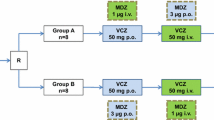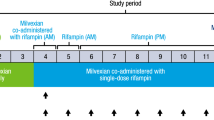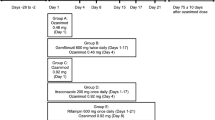Abstract
Objective: To determine the effects of treatment with itraconazole and rifampicin (rifampin) on the pharmacokinetics and pharmacodynamics of oral midazolam during and 4 days after the end of the treatment.
Methods: Nine healthy volunteers received itraconazole (200 mg daily) for 4 days and, 2 weeks later, rifampicin (600 mg daily) for 5 days. In addition, they ingested 15 mg midazolam before the first treatment, 7.5 mg on␣the␣last day of itraconazole administration, and 4 days␣later,␣and 15 mg 1 day and 4 days after the last dose␣of␣rifampicin.␣The disposition of midazolam and its α-hydroxy metabolite was determined and its pharmacodynamic effects were measured.
Results: During itraconazole treatment, or 4 days after, α-hydroxymetabolite the dose-corrected area under the plasma midazolam concentration–time curve (AUC0–∞) was 8- or 2.6-fold larger than that before itraconazole (i.e. 1707 or 695 versus 277 ng · h · ml−1), respectively. One day after rifampicin treatment, the AUC0–∞ of midazolam was 2.3% (i.e. 4.4 ng · h · ml−1) of the before-treatment value and only 0.26% of its value during itraconazole treatment; 4 days after rifampicin, the AUC0–∞ was still only 13% (i.e. 27.1 ng · h · ml−1) of the before-treatment value. The peak concentration and elimination half-life of midazolam were also increased by itraconazole and decreased by rifampicin. The ratio of plasma α-hydroxymidazolam to midazolam was greatly decreased by itraconazole and increased by rifampicin. In addition, the effects of midazolam were greater during itraconazole and smaller 1 day after rifampicin than without treatment.
Conclusion: Switching from inhibition to induction of cytochrome P450 3A (CYP3A) enzymes causes a very great (400-fold) change in the AUC of oral midazolam. During oral administration of CYP3A substrates that undergo extensive first-pass metabolism, similar changes in pharmacokinetics are expected to occur when potent inhibitors or inducers of CYP3A are added to the treatment. After cessation of treatment with itraconazole or rifampicin, the risk of significant interaction continues up to at least 4 days, probably even longer.
Similar content being viewed by others
Author information
Authors and Affiliations
Additional information
Received: 17 June 1997 / Accepted in revised form: 16 October 1997
Rights and permissions
About this article
Cite this article
Backman, J., Kivistö, K., Olkkola, K. et al. The area under the plasma concentration–time curve for oral midazolam is 400-fold larger during treatment with itraconazole than with rifampicin. E J Clin Pharmacol 54, 53–58 (1998). https://doi.org/10.1007/s002280050420
Issue Date:
DOI: https://doi.org/10.1007/s002280050420




